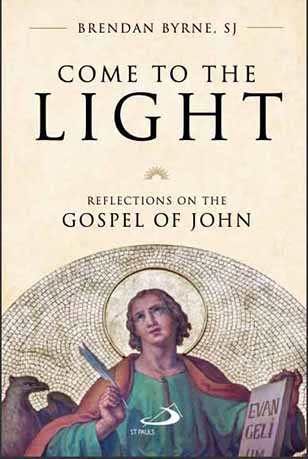 Come to the Light: Reflections on the Gospel of John
Come to the Light: Reflections on the Gospel of John
Brendan Byrne SJ
Most of us have a favourite Gospel. Mine is the Gospel of Mark. It is brief, full of stories, sharp sayings and enigmatic endings. It calls for action. The Gospel of John is different. It is full of long and mysterious speeches and of misunderstandings, and contains some beautiful and touching stories that momentarily come down out of the clouds, only for the Gospel to return there. It is for contemplatives. I confess that I have admired it but not warmed to it.
For me, then, the invitation issued by the title of Brendan Byrne’s book of reflections on John’s Gospel to come to the light was welcome. Arising out of retreats that he had given, the book promised both to uncover the spiritual depth of the Gospel and to find a flight path through the clouds. It was helpful in both respects. It drew on his depth of research, teaching and preaching on the Gospel of John to explain clearly how John works in the Gospel and to draw the reader into the drama that it contains.
As you might expect from a book based on retreat lectures, it follows the structure of the Gospel. It focuses on the major stories in the Gospel, attending to the movement of the dialogues associated with them. By exploring the chains of misunderstandings and apparent non sequiturs in the conversations Byrne brings to life the drama in which Jesus brings his disciples, his audiences and his enemies to a new understanding of his mission. He makes clear the two levels at which the stories work: the level of what a detached observer might see, and the richer level of the divine and human significance of what is taking place. The reader’s struggle through misunderstanding and Jesus’ correction to decode the stories and so to enter Jesus’ meaning echoes that of Jesus’ interlocutors. Both they and readers need to hang in until the deeper meaning of the events and of Jesus’ mission become clear.
For John the stories of Jesus are already coded by reference to stories, images, quotations and practices recorded in the Old Testament. The rich meaning of a story set at Passover time, for example, will be discovered by setting the story of Jesus alongside the original Passover story. The stories and allusions that John draws on all have to do with God’s relationship to Israel both then and in the present. That is the richer level to which Jesus leads his hearers, and John his readers.
For most modern Catholics the coding of the stories about Jesus is concealed. The Passover is a time of the year, not a celebration central to our remembering and imagining of our identity. That poses the challenge of making the Gospel stories live. Byrne does this by appealing to the Ignatian spiritual tradition of entering the stories imaginatively. This can be done in different ways. In much Catholic devotional writing and preaching writers focus on the psychology of the actors in the stories and on modern parallels with the events to bring them into the present day. The story of Jesus’ trial and crucifixion, for example, will be described in graphic detail, with reference to similarly brutal actions today. In this way the humanity of Jesus and the reality of his world will be brought out.
Byrne’s approach is quite different. He deals sensitively and briefly with the context of the stories and how it would have affected the participants. But he then focuses on the salient ways in which the stories are coded, illuminating the imagery and the scriptural references crucial for understanding the richer meaning of the story. These pose the question which in the dialogue Jesus puts to his listeners and to us: if this is the way in which God has acted in the great stories of Scripture of feeding, healing, freeing and so on, what is the significance for you now of my actions and relationship to God? The drama of the Gospel is of Jesus leading his listeners from disengagement to misunderstanding, to puzzlement, to some understanding, to acceptance or rejection, and to the next story. The flight path takes us in and out of fog, each time more deeply.
In taking his readers on this journey Byrne draws lightly on a lifetime of Scriptural study in order to pick out and explain clearly the significance of key allusions through which the deeper meaning of the story is conveyed. This together with his brief and vivid characterisation of the persons whom Jesus meets takes the reader more deeply into the Gospel, and so into prayer and into the faith that seeds commitment. He is a good pilot.
St Pauls
ISBN 9781925494723